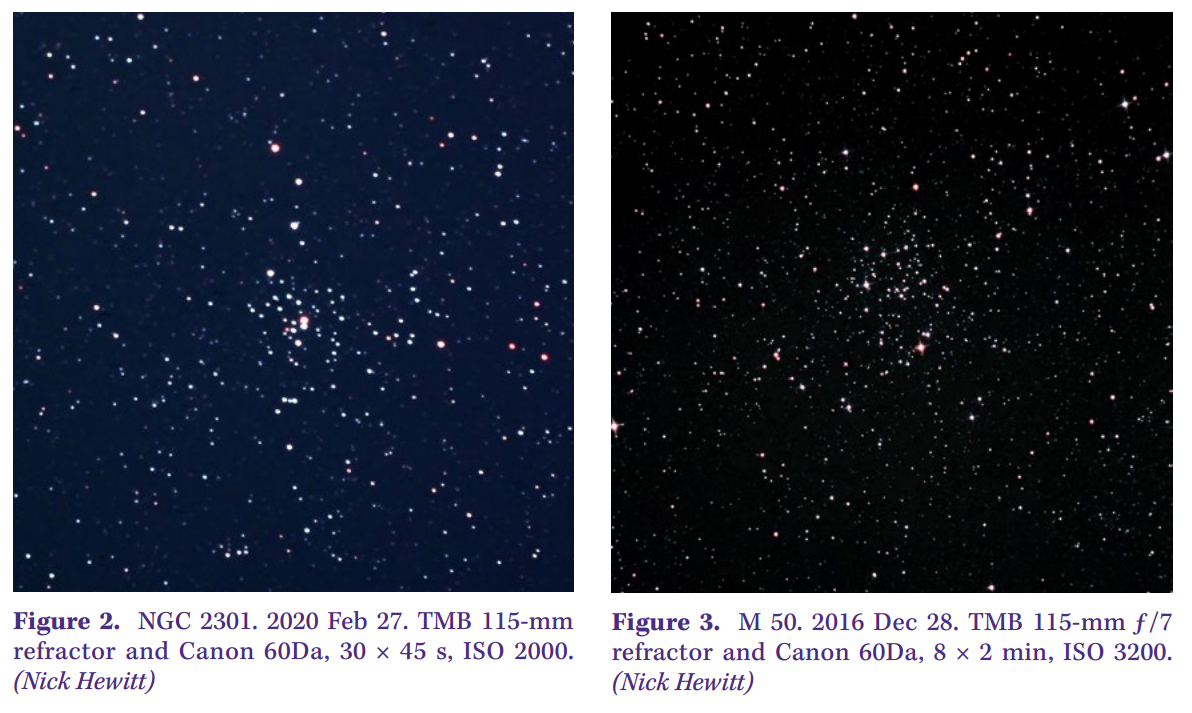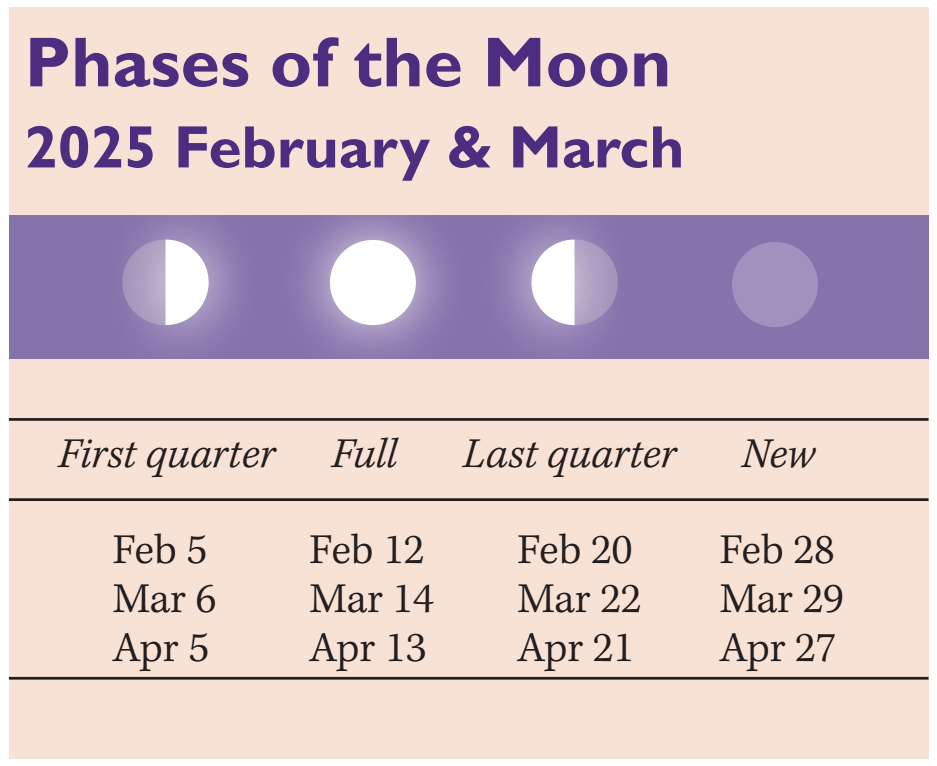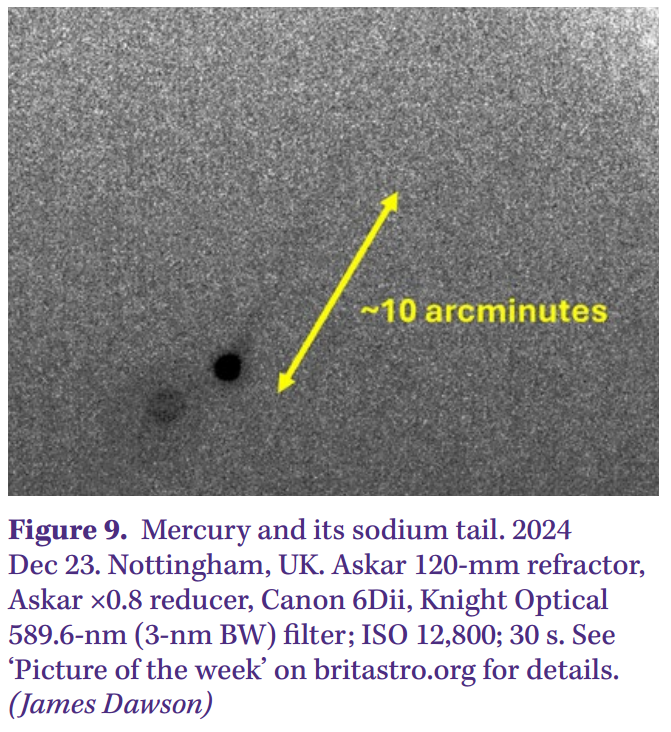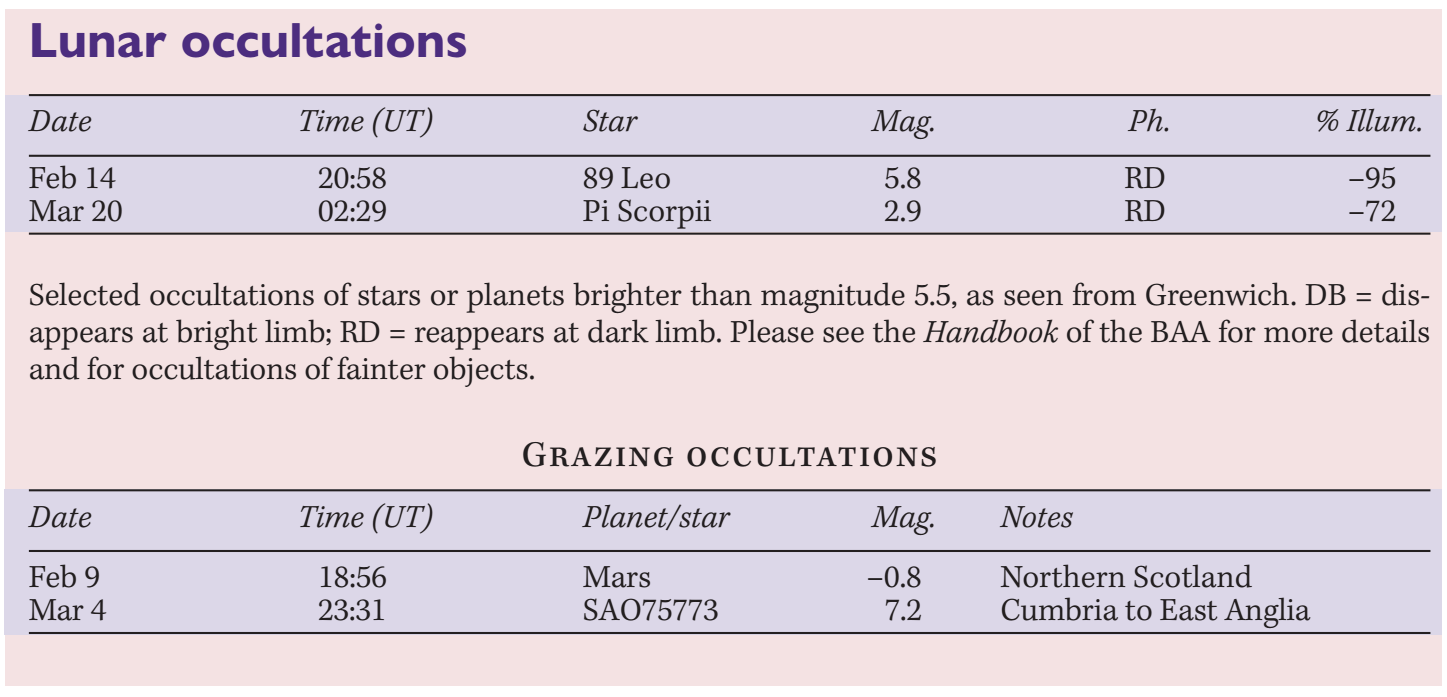Sky notes for 2025 February & March
2025 February 1

For many, February has one redeeming feature – it is short. But for astronomy enthusiasts, it has the transition from the glories of the winter Milky Way into the deep, galaxy-studded void that is the ‘Realm of the Nebulae’. The nights are still long enough for prolonged observing, although the vernal equinox on Mar 20 heralds the longer days, and British Summer Time forces light evenings on us from Mar 30.
February evenings remain a productive time for planetary observers, with Jupiter and Mars still high in the evenings, and Venus is now stunning throughout the month. Even speedy Mercury has a decent showing in early March. But the season is just marvellous for deep-sky aficionados.
The deep sky
The ‘Cosmic G’ is a most unofficial asterism on the largest of scales. It is made up of nine of the brightest first-magnitude stars of the late winter and is an aid to newcomers learning the constellations beyond Orion, the Hunter. Starting with Aldebaran, move northeast to Capella, then down to Castor and Pollux in Gemini, currently hosting Mars. Swing south via Procyon to Sirius, the brightest of stars in our night sky, and further west to Rigel. A northern sweep brings us to Bellatrix and the capital G is completed with ruddy Betelgeuse. At a stroke, six constellations are identified, and the beginner has a start on the absorbing journey that is astronomy.
There may seem a void within the ‘G’, to the east of Orion. The mythical unicorn, Monoceros, occupies this area, and though it is devoid of bright stars, it is choc-a-bloc with deep-sky marvels. Nebulae and clusters abound, some famous, and many less well known.
One of the easiest to locate, and a favourite objects for imagers, is the Rosette Nebula, NGC 2337–39. Its distinctive cluster, NGC 2244, is easy in binoculars but the surrounding nebulosity is a real challenge for visual observers. The complex is east of Betelgeuse and some two-and-a-half degrees south. A finder will show the distinctive 6th- and 7th-magnitude stars that are responsible for chiselling out the excited hydrogen from the centre, and then if low power is used, hints of nebulosity can just be discerned. Stunning detail can be obtained with narrowband filters when imaging.
North of the Rosette is a complex of emission and reflection nebulosity surrounding a cluster, with an iconic dark nebula thrown in for good measure. The Christmas Tree Cluster, NGC 2264 (Figure 1a, previous page), is easy enough to find, and slightly resembles an upside-down Christmas tree, with the bright variable star S Monocerotis as its base (although at its northern-most aspect; the tree is erect, of course, in many astronomical telescopes). S Monocerotis is a hot O-type star, slightly variable and also a multiple, being both a spectroscopic binary and an optical double with a companion at 3 arcsec. At the fairy/angel end of the tree is an iconic dark nebula: the Cone Nebula (Figure 1b). Outlined against the bright background that is being ionised by S Mon, the Cone is a dense cloud of cold molecular hydrogen with a glowing tip at the apex.
Below this extraordinary complex lies the easiest of the variable nebulae to observe and monitor. NGC 2261 is known as Hubble’s Variable Nebula, a young stellar object with a prominent northerly outflow (the southern component is only detectable in very deep images or infrared). Although the nebula was discovered by William Herschel, the variability was spotted by Edwin Hubble in 1916 so has his name. The star generating the outflow is R Monocerotis, its variability first recorded by Julius Schmidt from Athens Observatory in 1861.
Further southeast of the nebulae described lie many open clusters that litter the winter Milky Way through Monoceros and into Canis Major, most being under-observed. Nights exploring them are most rewarding.

One of the best is NGC 2301 (Figure 2), a William Herschel discovery of 1785. He described a ‘beautiful cluster much compressed, above 20′ in diameter’. It seems to have picked up a variety of unusual nicknames recently, including the ‘Great Bird’ cluster, ‘Hagrid’s Dragon’, and ‘Copeland’s Golden Worm’. It lies half a degree north of the celestial equator and at magnitude 6, it is easy enough in a finder at some 15 arcmin in diameter, although it shows a marked north-south bias with a stream of 8th- and 9th-magnitude stars.
Further east, we reach the sole Messier object in the Unicorn, M 50 (Figure 3). At magnitude 6, it is easy in a finder or binoculars. The orange star on the southern aspect is prominent when large-aperture telescopes are brought to bear on this rich cluster of 150 stars.

To the southeast of M 50 lies a colourful complex for imagers, featuring a mass of nebulosity and clusters on the Monoceros–Canis Major border. Within a low-power field are five clusters: NGC 2353, NGC 2343, and NGC 2335, with the faint Collinder clusters 465 and 466. These act as guides to the Seagull Nebula, IC 2177 (Figure 4), which has a huge north-south span of 3 degrees. Isaac Roberts discovered the brightest portion (the Seagull’s head), while the wings were captured by Max Wolf; both were pioneer astrophotographers of the late 19th and early 20th centuries.

As the weeks pass, spring enters softly, and the Great Bear awakens from its hibernation in the north, heralding warmer times to come. Dubhe and Merak, the ‘Pointers’, guide us to the Pole Star, Polaris, as the Great Bear swings around it into the northeast, circling its smaller companion, Ursa Minor. Leading Ursa Major is a famous pair of close but contrasting galaxies, M 81 and M 82 (Figure 5, p. 71). The former is sometimes known as Bode’s Galaxy and is a ‘grand design’ spiral, a beauty that is much imaged. Its companion, which can be seen in a low-power eyepiece, is the irregular starburst galaxy M 82 – the Cigar Galaxy. The pair can be found in large binoculars by extrapolating a line from Phecda (gamma UMa) through Dubhe (alpha UMa) and beyond by a similar distance. Deep imaging of M 82 (Figure 6) shows marvellous detail of energetic goings-on in the centre of the galaxy, caused by a tidal encounter with its more massive neighbour.


An outlying member of the M 81 Group is NGC 2403 (Figure 7), another fine spiral galaxy, although it is trickier to locate because it lies in a relatively barren area. The nearest bright star is Muscida (omicron or 1 UMa), but the galaxy resides in Camelopardalis, a constellation notorious for its faintness and large size. It is easier to use a Go-To system, but less fun!

If NGC 2403 proves too difficult without a Go-To facility, try other sights in Ursa Major such as M 108 and M 97 (Figure 8) that lie just southeast of Merak (beta UMa). M 108 is a barred spiral galaxy that we see almost edge-on. It has a clumpy appearance due to markedly bright areas but also much dark material. M 97 is also known as the Owl planetary nebula, first recorded by Pierre Mechain in 1781 Feb. Although magnitude 9.9, it can be difficult as its low-surface-brightness disc extends over 3 arcmin in diameter. With larger-aperture telescopes, the central star (magnitude 14) can be seen, and the dark ‘eye-patches’ become more obvious.
The solar system
Eclipses
There is a total eclipse of the Moon on Mar 14, but unfortunately for UK observers it sets during the eclipse, and before totality. North America has the full eclipse, with over an hour of totality to enjoy.
A partial eclipse of the Sun on Mar 29 is visible from the UK, and at a convenient time. The maximum chunk of Sun eclipsed is seen just after 11 am (UT), when around 40 per cent of the photosphere is obscured, although this is dependent on location. No totality is visible from anywhere on Earth and we shall wait until 2026 Aug 12 for the next total solar eclipse.
Sun
It is hoped that the Sun’s activity will extend into the spring and March may be a good month to catch aurorae. Our Sun slips over the celestial equator on Mar 20.

Planets
February is the last chance to see the planets satisfactorily for a while. The month begins with a fine lineup of Venus, the crescent Moon and Saturn in the early evening. Although Neptune is present, it is exceedingly difficult to pick out. By the end of March, we lose much of what is interesting in the solar system for several months.

Mercury (Figure 9) has its best evening showing of the year in late February and early March, reaching eastern elongation on Mar 8 when at magnitude −0.5. On Mar 4, it is directly below Venus, which should aid location.

Venus itself is a superb sight in the early evening in the southwest during February, but then becomes increasingly difficult as it speeds towards inferior conjunction on Mar 23. At that point, it passes 8° north of the Sun. However, as this is still dangerously close, only the most experienced observers should attempt to capture it either side of this date. At the beginning of March, Venus’ disc is almost 50 arcsec and the crescent very thin; by inferior conjunction, the planet is just short of 1 arcmin across.
Mars (Figure 10, below) remains well up in Gemini throughout February and March, resuming its prograde motion on Feb 23. Nevertheless, observation becomes trickier as the planet’s apparent diameter shrinks from 13.6 to 8.3ʺ and fades from magnitude −0.8 to +0.4 over the same period, so best to enjoy it during February for the most satisfactory views.

Jupiter still dominates the late winter sky, lying north of Aldebaran and the Hyades throughout this period.
Saturn finally dips into the west, with its conjunction with the Sun occurring on Mar 12. The rings remain almost edge-on, with a tilt of 2.8°. The ring-plane crossing occurs on Mar 23, at which point the planet is not observable.
Uranus, located in Aries, remains easily observable during the evenings of February and March at magnitude 5.8 and showing a diameter of 3.47ʺ.
Neptune is at solar conjunction on Mar 19 so no longer well placed, although it joins Venus, the crescent Moon and Saturn on Feb 1.
Meteors
This is a poor season for meteors, there being no major showers during February or March. Two minor showers may be observed, although the Delta Leonids, derived from Comet 55P/Tempel–Tuttle, are at their maximum on Feb 25 when the Moon does not interfere. The Pi Virginids, although usually weak, peak during the first week of March when the Moon will not be a nuisance.
Comets
At the time of writing, there is a dearth of easily observable comets during February and March
| The British Astronomical Association supports amateur astronomers around the UK and the rest of the world. Find out more about the BAA or join us. |
